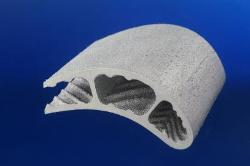May 4 2010
Aircraft engine components must perform under extreme conditions: they must rotate more than 1000 times in a single second, with-standing temperatures of up to 2000°C and extreme pressures.
 This is a patch produced by SLM and welded into PW4000 HTP vane.
This is a patch produced by SLM and welded into PW4000 HTP vane.
At the same time, they should be as lightweight as possible and yet satisfy the most stringent standards for safety. Given all of these factors, the tasks of developing and servicing aircraft engines pose major challenges for engineers.
Researchers at the Fraunhofer Institute for Laser Technology ILT in Aachen, Germany, use selective laser melting (SLM). With this method, the part can be built up, layer by layer, on a building platform using a powder-based material. In essence, this process is comparable to that of a computer printer, except that it takes place in three dimensions. Based on computer-generated design data for the planned part, the metal powder is applied to the appropriate areas of the substrate and then immediately melted into place with a high-power laser beam. This forms a permanent bond with the portion of the object that is already complete – and materials tests have found that the quality of components produced using this method is at least as high as that of parts manufactured using conventional methods.
SLM has great potential: "With this process we can not only make perfect repairs to damaged engine parts but also build complete components that cannot be produced using conventional methods such as milling or casting," observes Dr. Konrad Wissenbach of ILT. "This also permits the kinds of geometries and designs we once could only dream of." Indeed, the figures speak for themselves: with this and other laser-based generative methods, manufacturing cycle times can be reduced by 40 percent or more. In the future, this will mean savings of up to 50 percent of the material required, and at least 40 percent of repair costs. Wissenbach is coordinator of the 6.5 million euro, EU-sponsored FANTASIA project – an acronym standing for "Flexible and near-net-shaped generative manufacturing chains and repair techniques for complex shaped aero engine parts." The project will conclude at the end of May 2010. ILT researchers will brief the world of experts on the findings the project has generated at the 8th International Laser Technology Congress AKL'10 May 5-7, 2010, in Aachen, Germany.
The SLM approach is not suitable for every turbine material just yet. "We have already seen very good results with Inconel 718, a nickel-based superalloy, and with titanium alloys as well," Wissenbach remarks. "We are not quite as far along with other fissure-prone materials." Here, ILT researchers are continuing the search for ways of using melting or molding to reseal any cracks a part may have developed during use. Of course it would be even better if cracking could be prevented altogether. This is why the engineers are experimenting with different parameters, varying laser output power, beam geometry and the structure strategy.. They are also investigating the effects of construction-platform preheating on product quality. The productivity of the method needs to be further improved as well, because with a coating thickness of 30-100 micrometers, larger components can take quite a long time to produce. "This is an area where we can combine a larger beam diameter for large surfaces with a smaller diameter for the contours," Wissenbach says. "By doing this, we want to increase our speeds by a factor of ten."